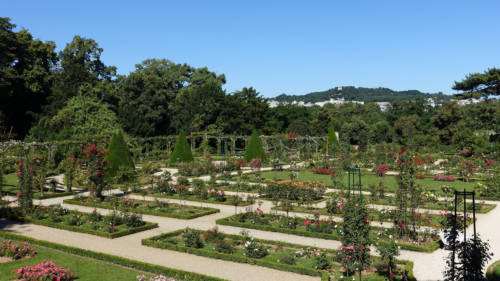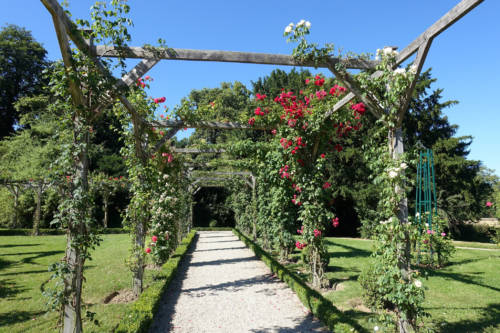
Hidden in Paris’s 16th Arrondissement, Parc de Bagatelle Does Not Disappoint
Deep in the forest of the Bois de Boulogne, in Paris’s 16th arrondissement, an ancient stone wall protects a luxurious botanical garden that when uncovered, feels like a genuine discovery.
Competing as it does with far more famous attractions– the likes of which include the Eiffel Tower or the gardens of Versailles– the Parc de Bagatelle is frequently overlooked by visitors to Paris, and even by Parisians themselves. As a result, it retains the feeling of a secret garden, a mystery compounded by its location – hidden away in the vast acreage of the Boulogne woods.
The park’s colorful history began in 1777 with a bet between Marie Antoinette and her cousin, the Count of Artois. The challenge: build a chateau and gardens in under two months. Almost a thousand workers and exactly 64 days later, the Parc de Bagatelle was born. Designed by Scotsman Thomas Blaikie after the anglo-chinois model (new images of Chinese pagodas were all the rage in France), the gardens were seen as a reaction against the strict constraints of classical French style.
After passing through the hands of several private owners who made various improvements (including the addition of ornate entrance gates, stables, and an orangerie in the 1860s), the park was taken over by the city of Paris in 1905. Jean-Claude-Nicolas Forestier, the park’s original conservateur, or head gardener, was the driving force behind its current reincarnation, transforming the terrain into lush botanical gardens while maintaining the original 18th century rococo temples, grottos, and lakes.
Even on a warm Sunday in early September, the gardens are practically deserted, the only sound being the skylarks in the trees. Joggers and cyclists are banished to the surrounding woods, and the 6€ entrance fee acts as a further deterrent to casual passersby. Walking along a bamboo-shaded path, the heady scent of roses invites us into the rosarium, where the late bloomers strut their stuff. With 1,200 varieties of rose bushes, that both climb and ramble, this garden is the pride of Bagatelle: an international competition of new roses has been held here every summer since 1907. A stroll along the structured rows reveals the yellow and coral beauty of the Pullman Orient Express, a showy fuschia Baronesse, and a Constanze Mozart variety of the palest pink. Belle de Clermont, Excentrique, Nefertiti – the names are the purest poetry, and to cap it off, the sudden sounds of a piano concerto drift over the gardens. A classical music festival, Les Solistes à Bagatelle, is underway in the Orangerie. Très civilisé!
“Deep in the forest of the Bois de Boulogne, in Paris’s 16th Arrondissement, an ancient stone wall protects a luxurious botanical garden that feels like a genuine discovery.”
Passing quickly through the long iris gardens – the irises are at their best in May and June, as are the peonies along the west wall – we pause to appreciate the smaller surrounding gardens. How the crisply-boxed French hedges contrast with the wilder English-style plantings, like daisies and phlox. Then, through a little wooded path, you’ll find the enviable kitchen garden. Among the rows of spinach, tomatoes, courgettes and beans – enough to feed an army with salads and soups – are some more unusual edible plants. Like oca (Oxalis tuberosa) from Peru, a perennial whose tubers can be cooked up in water. In addition to the trailing clematis, little pommiers, or apple trees, are espaliered up dividing trellises. A closer look a Delbord Jubilé reveals a twist: the trunk has been divided in two, and then two again, to create a sort of living family tree. It presumably bears more fruit than one with a single trunk.
On the other side of the charming brick gardener’s house lie the walled presentation gardens, a melange of perennial and other plantings that offer the Bagatelle gardeners a chance to really show off. For this year’s Décoflo (a competition between Parisian gardeners), they’ve taken inspiration from a vintage box of bonbons, transforming the marshmallow, lemon and vanilla flavors into a riot of yellow and white blooms– white verbena, cosmos, dianthus and acasta, diascia and the ever-present asters, a feature the garden has come to celebrate. Fat bees cross paths mid-air with delicate butterflies, while the neo-Roman statues gaze serenely out at the gorgeous scene.
Heading north along the west wall, we come to the chateau itself, a pink wedding cake of a building in typical 18th century style, complete with a classical courtyard accessed through the extravagantly-named Pavilion of the Rose of the Winds, a circular court bordered with more statuary. The aromatic plant garden here is echoed further along in the Seine Gallery, a living exhibition exploring a changing theme. At the moment it seems to be spicy edibles, and horseradish, mustard, and pepper plants in orange pots are surrounded by intense red dahlias to enhance the fiery display.
On the other side of the chateau a couple sits facing each other on the grass, nuzzling noses while a professional photographer snaps away. Still, the sense of being alone in a hidden garden remains; so far we’ve encountered only a handful of well-heeled families from the neighboring suburb of Neuilly-sur-Seine. Walking towards another garden – Bagatelle seems to contain any number of them, each with a different character – we pass a stunning weeping beech sighing over a water-lily pond. Forgoing the oak wood for the conifer forest, we surprise a peahen and her two chicks. We’re about to take a closer look, when a peacock bearing down from behind a monkey puzzle tree makes us quickly change our minds.
In addition to its beautifully-kept botanical gardens, Bagatelle is bursting with folies– the various little grottos, ruins, temples, pagodas, and waterfalls that were a fashionable feature of the 18th century style. Around every corner is another discovery, and the strong sense that in a crowded Paris, this garden is a very well-kept secret.













































